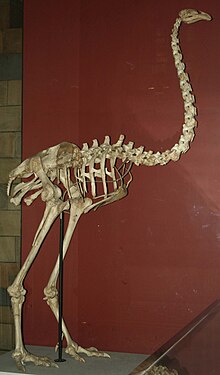Our website is made possible by displaying online advertisements to our visitors.
Please consider supporting us by disabling your ad blocker.
North Island giant moa
| North Island giant moa Temporal range: Late Pleistocene– Holocene
| |
|---|---|

| |
| Skeleton, Natural History Museum of London | |
| Scientific classification | |
| Domain: | Eukaryota |
| Kingdom: | Animalia |
| Phylum: | Chordata |
| Class: | Aves |
| Infraclass: | Palaeognathae |
| Order: | †Dinornithiformes |
| Family: | †Dinornithidae |
| Genus: | †Dinornis |
| Species: | †D. novaezealandiae
|
| Binomial name | |
| †Dinornis novaezealandiae | |
| Synonyms | |
|
List
| |
| Measurements | |||
|---|---|---|---|
| North Island [3] | |||
| Length | 240 cm (94 in) | ||
| 300 cm (120 in) | |||
| Weight | 55–88 kg (120–190 lb) | ||
| 78–249 kg (170–550 lb) | |||
The North Island giant moa (Dinornis novaezealandiae) is an extinct moa in the genus Dinornis, known in Māori as kuranui.[4] Even though it might have walked with a lowered posture, standing upright, it would have been the tallest bird ever to exist, with a height estimated up to 3.6 metres (12 ft).[citation needed]
- ^ Brands, S. (2008)
- ^ Checklist Committee Ornithological Society of New Zealand (2010). "Checklist-of-Birds of New Zealand, Norfolk and Macquarie Islands and the Ross Dependency Antarctica" (PDF). Te Papa Press. Retrieved 4 January 2016.
- ^ Birds of New Zealand[not specific enough to verify]
- ^ Doyle, Trent (15 November 2023). "Scientists reveal fossilised moa footprints in Otago are at least 3.6 million years old". Newshub. Retrieved 23 February 2024.
Previous Page Next Page


